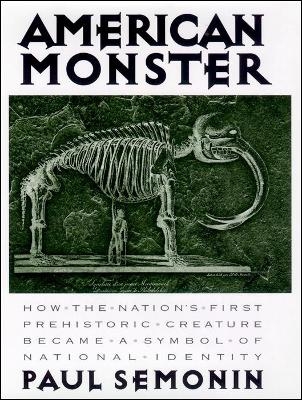
American Monster
How the Nation's First Prehistoric Creature Became a Symbol of National Identity
Seiten
2000
New York University Press (Verlag)
978-0-8147-8120-3 (ISBN)
New York University Press (Verlag)
978-0-8147-8120-3 (ISBN)
Dinosaurs and a quest for national identity are the order of the day with Semonin's "American Monster". This is a novel look at how the unearthing of the first complete mastadon skeleton became synonymous with the aspirations of a newly independent United States.
Fresh insights into the ongoing fascination with dinosaurs and their place in 19th century American nationalism
In 1801, the first complete mastodon skeleton was excavated in the Hudson River Valley, marking the climax of a century-long debate in America and Europe over the identity of a mysterious creature known as the American Incognitum. Long before the dinosaurs were discovered and the notion of geological time acquired currency, many citizens of the new republic believed this mythical beast to be a ferocious carnivore, capable of crushing deer and elk in its "monstrous grinders." During the American Revolution, George Washington and Thomas Jefferson avidly collected its bones; for the founding fathers, its massive jaws symbolized the violence of the natural world and the emerging nation's own dreams of conquest.
Paul Semonin's lively history of this icon of American nationalism focuses on the link between patriotism and prehistoric nature. From the first fist-sized tooth found in 1705, which Puritan clergyman claimed was evidence of human giants, to the scientific racialism associated with the discovery of extinct species, Semonin traces the evangelical beliefs, Enlightenment thought, and Indian myths which led the founding fathers to view this prehistoric monster as a symbol of nationhood.
Semonin also sees the mystery of the mastodon in early America as a cautionary tale about the first flowering of our narcissistic fascination with a prehistoric nature ruled by ferocious carnivores. As such, American Monster offers fresh insights into the genesis of the ongoing fascination with dinosaurs.
Fresh insights into the ongoing fascination with dinosaurs and their place in 19th century American nationalism
In 1801, the first complete mastodon skeleton was excavated in the Hudson River Valley, marking the climax of a century-long debate in America and Europe over the identity of a mysterious creature known as the American Incognitum. Long before the dinosaurs were discovered and the notion of geological time acquired currency, many citizens of the new republic believed this mythical beast to be a ferocious carnivore, capable of crushing deer and elk in its "monstrous grinders." During the American Revolution, George Washington and Thomas Jefferson avidly collected its bones; for the founding fathers, its massive jaws symbolized the violence of the natural world and the emerging nation's own dreams of conquest.
Paul Semonin's lively history of this icon of American nationalism focuses on the link between patriotism and prehistoric nature. From the first fist-sized tooth found in 1705, which Puritan clergyman claimed was evidence of human giants, to the scientific racialism associated with the discovery of extinct species, Semonin traces the evangelical beliefs, Enlightenment thought, and Indian myths which led the founding fathers to view this prehistoric monster as a symbol of nationhood.
Semonin also sees the mystery of the mastodon in early America as a cautionary tale about the first flowering of our narcissistic fascination with a prehistoric nature ruled by ferocious carnivores. As such, American Monster offers fresh insights into the genesis of the ongoing fascination with dinosaurs.
Paul Semonin is a cultural historian and graphic artist. He received his Ph.D. in history from the University of Oregon. He lives in Eugene, Oregon and occasionally teaches history at Linfield College and Oregon State University.
| Erscheint lt. Verlag | 1.9.2000 |
|---|---|
| Verlagsort | New York |
| Sprache | englisch |
| Maße | 152 x 229 mm |
| Gewicht | 853 g |
| Themenwelt | Geschichte ► Allgemeine Geschichte ► Neuzeit (bis 1918) |
| Geisteswissenschaften ► Geschichte ► Regional- / Ländergeschichte | |
| Naturwissenschaften ► Geowissenschaften ► Mineralogie / Paläontologie | |
| Sozialwissenschaften | |
| ISBN-10 | 0-8147-8120-9 / 0814781209 |
| ISBN-13 | 978-0-8147-8120-3 / 9780814781203 |
| Zustand | Neuware |
| Haben Sie eine Frage zum Produkt? |
Mehr entdecken
aus dem Bereich
aus dem Bereich
Europa 1848/49 und der Kampf für eine neue Welt
Buch | Hardcover (2023)
DVA (Verlag)
48,00 €
Giordano Bruno - ein ketzerisches Leben
Buch | Hardcover (2024)
C.H.Beck (Verlag)
29,90 €


